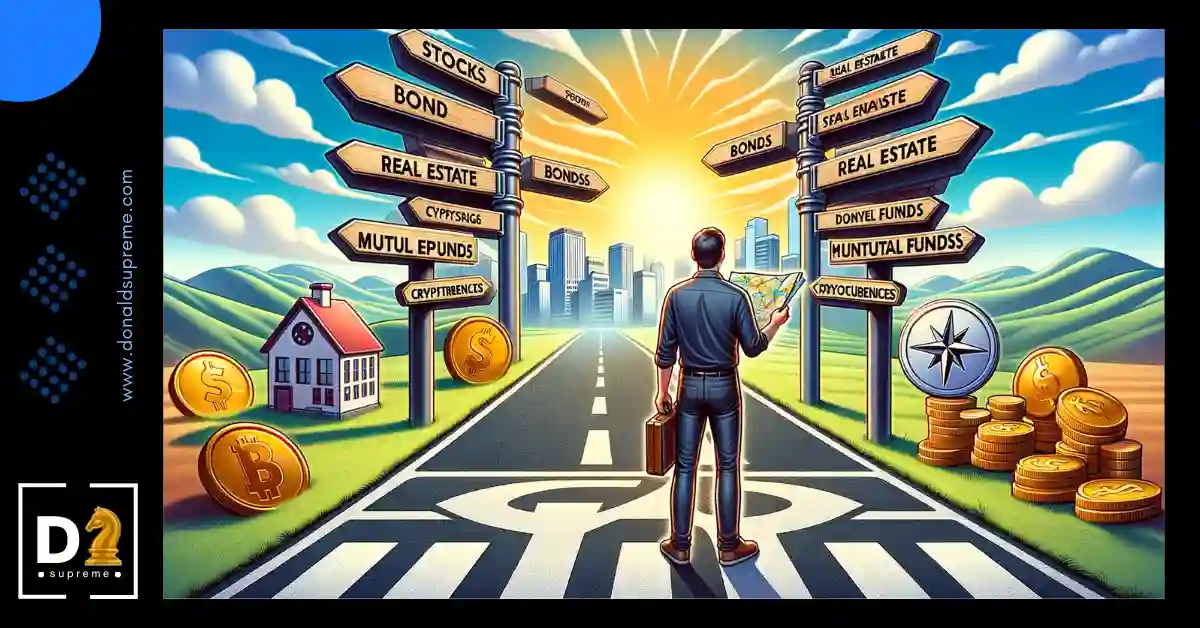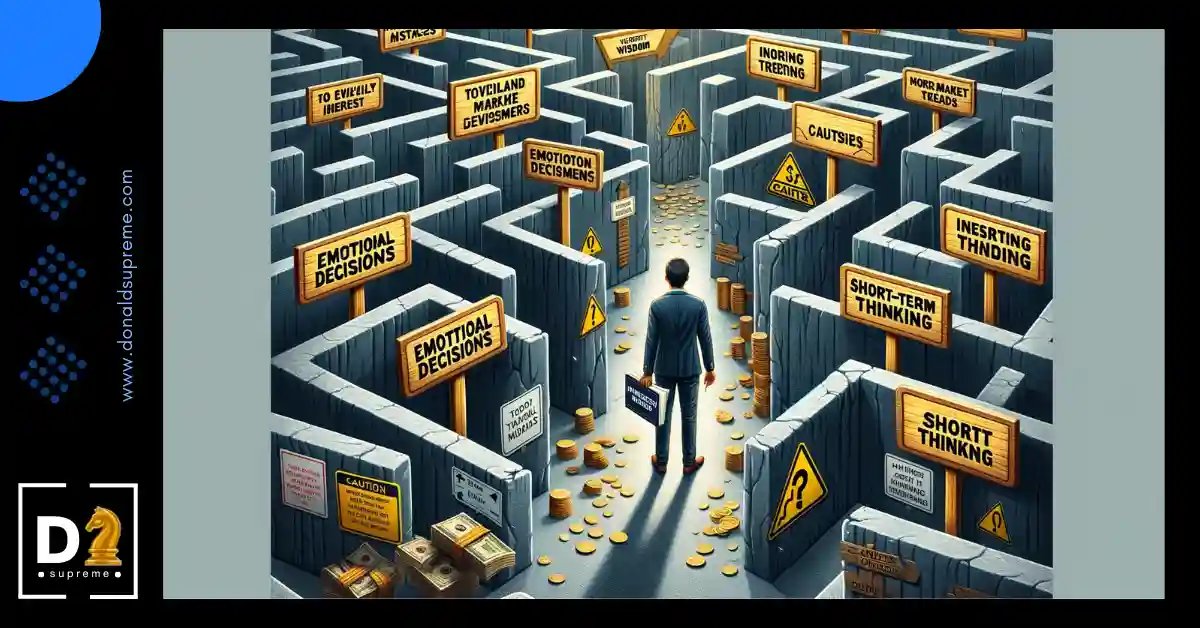Investing isn’t just for the rich or the finance gurus. Think of it as the ultimate hack for turning your hard-earned cash into a money-making sidekick.
It’s about making your money work for you, not the other way around.
Imagine this: while you’re crushing it at your day job or working on your latest side hustle, your money’s out there, getting buff in the financial gym.
And the best part? You don’t need a mountain of cash to start.
Now, before you dive into the world of stocks and bonds, let’s get real about spending and saving.
Check out our smart tips on money management, which talks about how to get your budget in shape.
And if you’re curious about how to funnel more cash into your investments, we’ve got the lowdown on making money online and side hustles that can boost your buying power.
Ready to make your money multiply? Let’s jump into the investment game.
TL;DR
- Investing is Accessible to All: Emphasizes that anyone can start investing, regardless of wealth level, to make their money work for them.
- Understanding and Diversifying Investments: Covers basics of different investment types like stocks, bonds, and mutual funds, and the importance of understanding personal risk tolerance.
- Generating Capital through Side Hustles: Discusses ways to earn additional income for investing, including online opportunities and side hustles.
- Importance of Money Management: Stresses budgeting, building an emergency fund, and managing debt as crucial for successful investing.
- Strategic Investment Planning and Avoiding Mistakes: Advises on creating a goal-oriented investment plan, diversifying investments, and avoiding common pitfalls like impulsive decisions and market timing.
Understanding the Basics of Investing
Ever feel like investing is a club where you don’t know the secret handshake? Let’s change that.
Investing is basically you putting money into something, like stocks or real estate, hoping it’ll grow over time.
It’s not a magic bean situation, but with a little patience and smart moves, it can turn into something pretty giant.

The first step is to know what to invest in. Stocks? Bonds? Mutual funds?
They’re all different flavors of investments, each with their own perks and quirks.
Stocks are like getting a slice of a company pie, and if the company does well, so do you.
Bonds are more like lending your friend money, and they pay you back with interest.
Mutual funds? Think of them as a potluck of different investments, managed by someone who knows their stuff.
Now, don’t just jump in the deep end. It’s crucial to figure out how much risk you can take.
Are you the ‘play it safe’ type, or are you okay with the investment rollercoaster? Your risk tolerance will decide what investment mix will work best for you.
Before you start buying stocks like you’re shopping for shoes, you need a game plan. That’s where a rock-solid budget comes in.
Navigate to our money management guide to get the lowdown on crafting a budget that works for you.
Making Bank to Bank On
So, you’re ready to invest, but your piggy bank’s looking slim? Time to beef up your wallet. The internet’s a gold mine if you know where to dig.
From selling your genius memes to freelancing your skills, there’s no shortage of ways to make some extra dough online.

Need some inspo? Click over to our article on online money and get those digital dollars rolling in.
But hey, maybe you’re the kind who likes to pound the pavement and get hands-on. Enter side hustles.
We’re talking about gigs that can be anything from walking dogs to selling handcrafted spaceship models.
The point is to find something you’re good at and turn it into extra investment cash.
Find out how, with our side hustle strategies that could make your wallet as fit as your new year’s resolution gym routine.
Setting the Stage for Investment – Money Management Fundamentals
Think of money management as your personal finance playlist – you need the right mix to get the party started.
It’s not just about counting your pennies but making those pennies march to the beat of your long-term goals.
And when it comes to investing, this is where you set the stage.

First up, let’s talk budgeting. It’s less about cutting out coffees and more about knowing where your cash flows each month.
A smart budget helps you find money you didn’t even know you had. By tracking your spending, you can free up some funds – that’s your investment starter kit.
Next is the emergency fund. It’s like the life jacket under your seat – you hope you won’t need it, but boy, are you grateful when you do.
Aim to stash away enough to cover three to six months of living expenses. This safety net means you won’t have to raid your investments if life throws you a curveball.
And debt? Let’s tackle it head-on. High-interest debt is a dream killer when you’re trying to invest. Work on a plan to pay it down, so it doesn’t eat up the money that could be growing for you.
But maybe you’re thinking, “Where do I find the money to manage?” Good news! The digital world is ripe with opportunities.
Get the scoop on converting your online time into real cash with our guide to online money. It’s your backstage pass to earning more, so you can invest more.
With the fundamentals of money management in place, you’re now primed to increase your investment funds.
We’ll delve into how you can do just that in the following sections.
Harnessing Online Money to Kickstart Your Investment Journey
Ready to turn your digital savvy into dollars? Welcome to the world of online money. It’s where hustle meets bandwidth and your earning potential skyrockets.
This isn’t about getting rich quick; it’s about using the internet as a tool to create a steady stream of income that can fuel your investments.
First, let’s decode making money online. You’ve got options like freelance writing, graphic design, or coding. If you’re a whiz at social media, consider digital marketing.

Online surveys, while not a gold mine, can still add a bit to your investment pot.
The key? Choose a side gig that aligns with your skills and interests to ensure it’s sustainable and enjoyable.
Don’t forget about passive income avenues, either. Setting up a blog or a YouTube channel can take work upfront, but with the right content, they can earn you money while you sleep.
Remember, consistency is your ally here. Create value, engage an audience, and monetize your platform with ads or sponsorships.
As great as online earnings are, they’re just one side of the coin. To really amp up your investment capacity, why not explore side hustles offline as well?
Our deep dive into side hustles will show you how to monetize your passions and talents in the real world, balancing them with your main job and life’s other commitments.
With a grip on money management and ways to earn online, you’re well on your way.
Next, we’ll explore how to parlay your skills into profitable side gigs that can further bolster your investment endeavours.
Amplifying Your Investments Through Side Hustles
Now, let’s switch gears from the digital realm to the tangible world of side hustles. These are your off-the-clock activities that can pack a financial punch.
Side hustles are about more than just a little extra cash on the side – they’re about cultivating a mindset where every dollar you earn can be a potential soldier in your investment army.
Think of your skills and hobbies. Can you turn them into a service?

Whether it’s crafting bespoke furniture, tutoring students, or freelancing your professional skills, there’s a market for your talents.
The gig economy has made side hustles easier than ever to start.
You’re not just earning money; you’re also gaining experience, expanding your network, and maybe even uncovering a passion.
The beauty of a side hustle is its flexibility. You set the pace. You control how much time and effort you put in, which means you can align your side gig with your investment goals.
Every extra dollar can be directed towards your future investments, getting you closer to financial freedom.
But where do you put these extra earnings for potential growth? While a savings account is safe, it’s not always the most effective for wealth building.
That’s where trading comes into play. Dive into our trading article to learn how you can actively manage your money to potentially outpace inflation and increase your capital.
Having expanded your income through online avenues and side hustles, it’s time to learn how to put that money to work.
In the next section, we’ll explore the dynamic world of trading as a means to grow your financial portfolio.
Trading as a Method of Investing
With some extra cash from your online endeavors and side hustles, you might be tempted to let it sit in a savings account.
But if you’re game for more action, trading can be your next move. It’s not for the faint of heart, yet it’s a path to potentially higher rewards.
Trading means buying and selling assets like stocks, bonds, or even currencies, and it can happen faster than you can tweet your favorite meme.

It’s all about timing and a bit of strategy. You buy at a lower price, sell at a higher, and the difference? That’s your profit.
But remember, with great potential comes great risk. It’s why trading shouldn’t be a financial wild west for your hard-earned cash.
It’s critical to get educated, maybe even simulate trades before going live. Platforms now offer ‘paper trading’ to practice without risking actual dough.
Yet, trading is just one vehicle on your investment highway. It’s about finding the right mix that suits your risk appetite and financial goals.
If you’re curious about the different ways you can put your money to work, stay tuned for our next section where we explore various investment vehicles that can help diversify your portfolio and minimize risk.
Investment Vehicles: Where to Put Your Money
Congratulations on accumulating some extra funds! Now comes the pivotal question: where should you invest them?
Think of the investment world as a buffet. There are plenty of options, and the best approach is often a well-balanced plate.

Stocks are a popular choice for a reason. They offer a share in a company’s success (or failure).
If picking individual stocks isn’t your style, mutual funds and exchange-traded funds (ETFs) provide a diversified slice of the market with a single purchase.
For those who prefer a steadier path, bonds can be a safer haven, offering regular interest payments and the return of your principal at maturity.
Or perhaps you fancy yourself a landlord? Real estate investments can provide both rental income and potential property appreciation.
Don’t overlook retirement accounts like 401(k)s and IRAs, which offer tax advantages and can be a cornerstone of your investment strategy.
And for those looking to thread a socially conscious path, sustainable investments allow you to put your money behind companies with ethical practices.
But remember, throwing all your cash into one pot isn’t wise. Diversification is key.
A mix of different investment vehicles can help you manage risk and tap into different economic sectors and geographies.
To manage this mix effectively, revisit our article on money management to ensure your investment choices align with your financial plan.
Remember, investing isn’t a sprint; it’s a marathon with ups and downs.
But with smart planning, a dash of courage, and a dose of patience, your financial goals aren’t just dreams – they’re destinations waiting for you on the horizon.
Creating an Investment Plan
Armed with knowledge and funds, you’re nearly set. But before you dive into the investment pool, you need a plan – a roadmap for your financial journey.
An investment plan acts like a GPS, guiding you towards your financial destination while helping you navigate through market ups and downs.
Start with your goals. Are you looking to buy a home, save for retirement, or start your own business?

Your objectives will influence how aggressively or conservatively you should invest.
Consider your timeline too; short-term goals may require a different strategy compared to long-term ones.
Risk tolerance is also a huge factor. Not everyone can stomach watching their investments rise and fall with the market’s whims.
Understanding your comfort level with risk will help you choose the right investments. Remember, higher potential returns usually come with higher risks.
Next, diversification – don’t put all your eggs in one basket. Spread your investments across different assets, so if one underperforms, you have others to balance it out.
Lastly, review and adjust regularly. Your life isn’t static, and your investment plan shouldn’t be either.
As your goals, timeline, and circumstances change, so should your plan.
With your investment plan in hand, you’re ready to take control of your financial future. But remember, the plan is only as good as your discipline in executing it.
Circle back to our essential money management strategies to help stay on track and adapt as necessary.
Your investment plan isn’t set in stone – it should evolve as you do.
Creating a thoughtful investment plan is the culmination of understanding your finances and your future aspirations.
It’s the blueprint that can help turn your dreams into reality, step by calculated step.
Whether you’re a cautious saver or a bold investor, the right plan will keep you moving forward, no matter what the markets throw your way.
Common Mistakes to Avoid in Investing
Embarking on your investment journey can be thrilling, but even seasoned investors sometimes veer off course.
To keep your financial ship steady, be aware of common pitfalls that could capsize your progress.

Acting on Impulse: The market can be volatile, and knee-jerk reactions can jeopardize your investment strategy. Stick to your plan unless there’s a sound reason to make a change.
Timing the Market: Trying to buy low and sell high can lead to missed opportunities. Time in the market generally trumps timing the market.
Consistent investing beats attempting to predict market highs and lows.
Overlooking Fees: Investment fees can eat into your returns like termites in a wooden house. Pay attention to expense ratios, transaction fees, and fund management costs.
Chasing Performance: Just because an investment was the star performer last year doesn’t mean it will shine forever.
Diversification is key to mitigating risk and should take precedence over chasing past results.
Neglecting Research: Don’t invest in something you don’t understand. Do your due diligence or consult a financial advisor to ensure an investment aligns with your strategy.
Underestimating Risks: Every investment carries risk. Assess how much risk is associated with each investment and ensure it aligns with your risk tolerance and goals.
Forgetting the Tax Implications: Investments have tax consequences. Understand how your investments will affect your tax bill and plan accordingly.
Investing wisely is about steering clear of these missteps while remaining aligned with your financial course.
Keep these lessons in mind as you forge ahead, and always remember the fundamentals of money management to keep your portfolio healthy and your strategy sound.
Avoiding these common investing mistakes can make the difference between a flourishing financial future and a cautionary tale.
Tools and Resources for Beginner Investors
As a beginner in the investment world, having the right tools and resources can be just as important as the capital you’re looking to invest.
With technology at your fingertips, you can access an array of aids that can help demystify the investment process and support your decision-making.
Investment Apps and Platforms: There are numerous apps out there designed for beginner investors.

They offer user-friendly interfaces, educational resources, and even automated investing based on your goals and risk tolerance.
Financial News Websites: Staying informed is crucial in investing. Websites like Bloomberg and CNBC provide up-to-date market news and analysis, which can help you make educated decisions.
Online Courses and Webinars: Knowledge is power, especially when it comes to investing. Platforms like Coursera and Udemy offer courses on investing basics, portfolio management, and more.
Books: There’s a wealth of knowledge in books written by investment gurus. “The Intelligent Investor” by Benjamin Graham is a classic that’s touted for its timeless advice.
Investment Calculators: Online calculators can help you project investment growth, understand compounding, and figure out your potential retirement savings.
Financial Advisors: If you’re unsure about going it alone, a financial advisor can provide personalized advice based on your financial situation and goals.
These tools and resources are at your disposal to ensure you’re well-equipped to tackle the investment landscape.
As you become more confident and your portfolio grows, you’ll find that these resources can scale with your evolving needs.
With all that you’ve learned, you’re ready to make informed decisions that align with your financial aspirations.
As we conclude, remember that investing is a journey of learning and growth. The right tools and resources can illuminate the path ahead, helping you to navigate with confidence.
Let’s summarize the key takeaways and reflect on how you can apply them to carve out your own successful investment story.
Conclusion
Investing isn’t just about growing your wealth; it’s about empowering your future.
Whether you’re starting with small steps in online ventures or side hustles, transitioning to active trading, or selecting diverse investment vehicles, the path is yours to forge.
Remember, an informed investor is a smart investor.
Create a solid plan, be mindful of common mistakes, and equip yourself with the right tools and resources to navigate the financial seas.
Along the way, never lose sight of the importance of sound money management. It’s the compass that ensures you stay on course, even in turbulent waters.
And as you grow, your strategies and tools should evolve too, keeping pace with your ambitions and the ever-changing market landscape.
So take a deep breath, and step forward with confidence. Your financial journey is a marathon, not a sprint, and every step, every learning curve, brings you closer to your goals.
Invest wisely, live well, and let your money work for you, laying the groundwork for a future that’s not just dreamed of, but planned for and achieved.
0



